by Winding Pathways | Nov 7, 2024 | Birds, Chickens, Garden/Yard, Nature
Cardinals and other birds visiting wintery backyard feeders need grit. They’ll appreciate finding some near the sunflower seeds and millet.
The old saying that something’s as scarce as a hen’s teeth is as true for the chickadees, cardinals, and goldfinches that visit backyards as it is for the hens in our coop. Birds have no teeth. Before they can digest coarse corn and wild seeds it must be thoroughly chewed. How do they do it?
What Is Grit?
Seeing birds along wintery roads solves the mystery. They’re picking up and swallowing tiny pieces of rock that will descend into their gizzard. A gizzard is a powerful muscular pouch that grinds tough seeds against grit, resulting in a seed slurry that then moves through the bird’s digestive system. Grit is a bird’s teeth.
When Is A Good Time to Spread Grit?
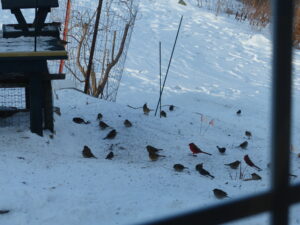
Birds flock to the seeds.
During warm months birds have no trouble finding tiny stones in bare patches of earth, but when the world is blanketed in snow or ice, they can’t find grit. Winter is when they appreciate swallowing a few tiny stones near bird feeders.
What Types of Grit Are Best?
As we fill our feeders at Winding Pathways, we sprinkle grit in with seeds and dribble some on the ground. We use two kinds of grit. When we have it on hand, we prefer baby chick grit that we buy at a farm store. It is tiny pieces of sharp quartzite that’s especially effective in grinding seeds in a gizzard. It’s sized for tiny baby chickens, so it’s just right for backyard feeder birds. When we don’t have it on hand we use regular sand. Traction and kid’s sandbox sand both work well and can be purchased at most home supply stores.
How Much Grit?
-

-
Birds flock to the seeds.
-
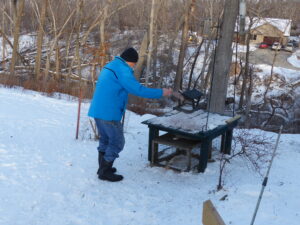
-
Sprinkle grit once a week to help birds in the snowy season.
-
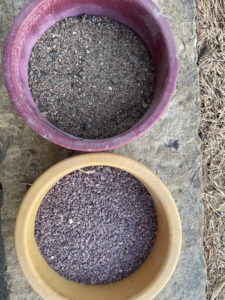
-
Spread grit when the ground is snow or ice covered.
Birds must have grit, but they don’t need much. A handful in and around feeders once or twice a week is plenty.
Other Uses
Grit’s useful around the house. When walkways are snow-slicked humans are mostly likely to slip and fall. Tossing grit on slippery walkways creates traction for people and may prevent a painful fall. Birds spot it there and occasionally pick up a few pieces. We keep about 50 pounds on hand and use most of it for traction and just a tiny fraction for our birds.
This winter when filling bird feeders scatter a bit of grit. Cardinals and other birds will appreciate it.
by Winding Pathways | Dec 7, 2023 | (Sub)Urban Homesteading, Birds, Nature
Why do Birds Fly Into Windows?
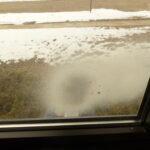
The spray makes the window opaque.
Windows, deadly for birds. According to the National Audubon Society, about one billion birds are killed every year when they crash into windows. About half collide with low commercial building windows with the rest crashing into home windows. Surprisingly few seem to crash into the high windows of skyscrapers.
Birds fly into windows because they just don’t see them and assume they’re about to zip through safe soft air. Sometimes they may see reflections of vegetation behind them and think they are zooming to a convenient perch.
How to Help a Bird
When Rich was director of the Indian Creek Nature Center, he’d often get calls from upset people who had just found a quivering bird beneath their window. In his experience one of two outcomes is likely. Either the bird will soon die or it will fully recover and fly off. He suggests leaving the bird alone for at least an hour unless it’s likely to fall prey to a hungry neighborhood cat. In that case, it is probably best to gently place it in a cardboard box to give it a chance to recover…or die.
Unfortunately, there’s no effective first-aid technique to reverse death. Hopefully, the bird will soon recover and speed away. If not, a respectful burial is in order.
Tips
Here are some tips from the Portland, Oregon, Audubon Chapter of the National Audubon Society for reducing window collisions:
- Place bird feeders away from large windows.
- Avoid putting house plants immediately inside windows. Birds may see them and attempt to fly to a perch.
- Put stickers/decals on the outside of windows. (Note: Many sources recommend these. Stickers can be bought online or at bird-feeding stores……but we, at Winding Pathways, have not found them very effective.
- Stretch netting across the outside of the window to physically keep birds from crashing. We’ve found this best on windows that experience frequent bird collisions.
- Put colorful tape on the outside of the windows.
- Douse outside lights. Come sundown our nation is way over-lit. Lights block viewing the magnificent night sky while often disorienting migrating birds.
We Can Help
Songbirds face many challenges in our modern world. They crash into windows, hit poles, get gobbled up by house cats, and are confused by electric lights. They need all the human help they can get to stay alive and healthy.
by Marion Patterson | Apr 13, 2023 | Amphibians/Reptiles, Birds, Flowers/Grasses, Hearing, Nature, Wonderment
A Season of Variables
After a drab March “look up, look down, listen” season is here. It’s exciting and frustrating. Always something to see and hear and things we miss, too.
What is look up, look down, listen? Well, when we walk in woods and prairies, we’re always attuned to nature’s beauty and curiosities. In the Northern Hemisphere April and May force challenges and delights, as the earth turns toward the sun. Its warmth stimulates new life while welcoming arrivals from down south.
Here in Iowa, like much of the United States, bird migration rises through April and peaks in early May. Woods, wetlands, and prairies are filled with bird species we haven’t seen since last year.
Look Up!
“Look up,” Marion remarked on one April walk last year. She spotted the first Rose Breasted Grosbeak of the season. He was perched on a thin branch high in a sycamore tree. As we walked along, we kept looking up to spot other new arrivals. They added color and song to those of cardinals, chickadees, and woodpeckers who are our neighbors all year.
-
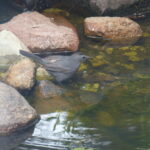
-
A catbird drinks by a pool.
-
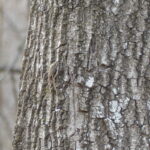
-
The brown creeper blends in with tree trunks.
Look Down!
After admiring the Grosbeak and moving on, I said, “look down.” We had been paying so much attention to birds up in the trees that we almost trampled a Dutchman’s Breeches, a delicate white wildflower with petals shaped like old-time Dutch pants. Looking down revealed spring beauties, Mayapples, hepatica, and anemones. Some were not quite in bloom and a few had gone by, but most were in their spring glory.
-
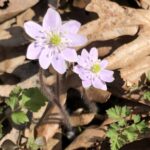
-
Early spring flowers
-
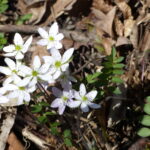
-
Reaching for the sun
-
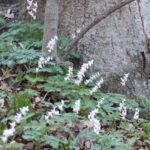
-
Dutchman’s Britches
-
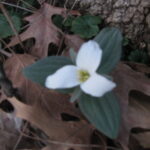
-
Snow Trillium
Shhhh! Listen
Passing a low wetland, we both paused to hear the songs of the chorus frogs and peepers that greet listeners each spring between the vernal equinox and Easter.
So, what do we do on a spring walk? Look up or down or listen? All of these. It is the best time of year to enjoy beauty clinging to the soil, singing from treetops, and chorusing from ephemeral pools.
Make Nature ID easier with Apps
Spotting birds hiding invisibly in tangles of branches and vines is challenging. What’s in that thicket singing? Thanks to the Cornell Laboratory of Ornithology, we turn on our Merlin app, point the phone where the songs originate, and learn who’s singing. Merlin is easy to download from the app store. Sometimes we are lucky and watch migratory birds close at hand.
Some people even lure birds in with treats that are eagerly consumed by arriving birds.
Wildflowers cannot hide but can be confusing. We sometimes use an app called SEEK to identify ones that are mysterious to us. SEEK is also easy to download from the app store and can also help identify trees, weeds, and other living things.
Look up, look down, listen! season may be the very best time to be outside. We love it.
by Winding Pathways | Oct 27, 2022 | Birds, Nature
Hi all: Many people either don’t have feeders for birds or have reduced their giving of seeds due to higher expenses. Yet, we still like to note birds around. We encourage you to join Cornell University’s Project FeederWatch. From the website click on “About” on the tab and read more details of how you can enjoy watching and documenting birds starting November 1st.
-

-
Bird watching is again a joy with hearing aids.
-
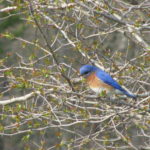
-
Bluebirds hang out on branches.
-
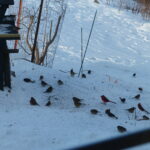
-
Birds flock to the seeds.
-
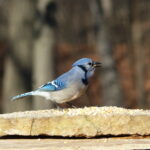
-
Usually jays come around only in winter.
-
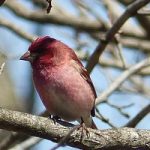
-
Some birds homestead at Winding Pathways.
-
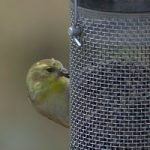
-
Songbirds appreciate high quality seed to sustain them in winter.
-
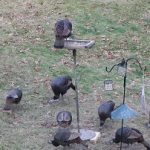
-
Turkeys and squirrels would make short work of seed, leaving none for the small birds.
-
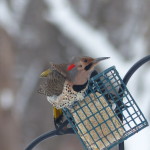
-
Winter is tough on birds so keep your feeders full.
-
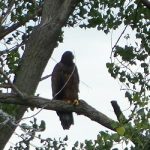
-
Fledgling eagle resting in the back yard.
by Winding Pathways | Sep 15, 2022 | (Sub)Urban Homesteading, Birds, Garden/Yard, Mammals, Nature, Pests
Guest Blog by Jackie Hull,
in the foothills of Virginia
Bears Barely Tolerable Behavior
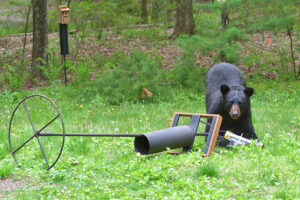
Bear Raiding Feeders
Well, the bear did it again. It tore up some of the spindles on the porch railing, tipped over a couple of the vegetable pots, and yanked a six-foot portion of our picket fence off the posts. All this to remind me that I should not feed the birds this time of year. It’s May.
So what to do but put away all the feeders? Maybe I can try again in the fall when bears retreat to the dens for their winter snooze.
This pretty much gave me great moments of sadness especially since I’ve had to shed other favorite activities.
Bird Antics Bring Joy
But today was a day of great surprises. My beautiful main stays, the birds, were everywhere. As I sat in the kitchen peering out the window, I spotted the adult turkeys poking their heads above the uncut hay. I could feel their parental thoughts “The coast is clear so keep scrambling forward.” The chicks were not seen but definitely there. A goldfinch zipped over them. Then I saw two wood thrashers near the holly tree scavenging for insects. Oh, my look how that crow struts!
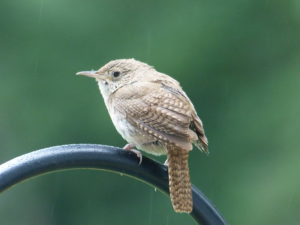
Wrens are Chatterers
Listen, that’s the wren by the back door. She keeps chattering to remind me she built her condo in the hanging planter. Then a flash of bright red caught my eye as I walked onto the porch. It’s a cardinal. Then the female house finch flicked from her nest over the front door light. She doesn’t like me stepping onto the porch. She is quite timid.
Even though the feeders have been down for nearly two months, the birds have kept their vigil at my country home much to my delight. They are in the trees, along the lane, and in the hayfield. What a great day!





















